Jinyang.com News Reporter Jiang Jun and correspondent Ling Haoxiang reported: How did mummies be made? What magic does the Book of the Undead have? Why is the Nile River that floods every year a gift from God to Egypt? On December 19, the final exhibition of the Guangdong Provincial Museum at the end of the year, “Echoes on the Nile River – Special Exhibition of Ancient Egyptian Civilizations” opened. 144 pieces (groups) and a total of 238 ancient Egyptian cultural relics were officially unveiled. Books of the Dead, small gold characters, Komiks Tower, Sphinx, etc. arrived in Guangzhou for the first time, recreating the mysterious ancient Egyptian civilization and completing a dialogue across time and space.
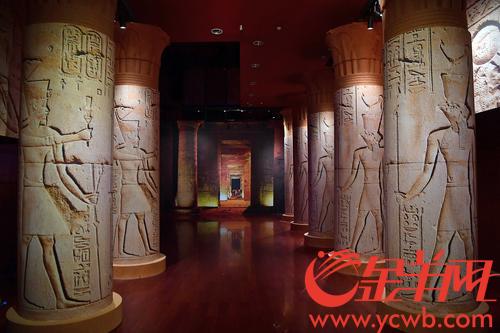 The Echo of the River Nile by the Babaylan——Special Exhibition of Ancient Egyptian Civilization Jinyang.com reporter Deng Bo
The Echo of the River Nile by the Babaylan——Special Exhibition of Ancient Egyptian Civilization Jinyang.com reporter Deng Bo
Three-dimensional and vivid ancient Egyptian civilization
This exhibition shows ancient Egyptian civilization from three perspectives: blessings from the gods, exploring immortality, and the banks of the Nile. As an iconic cultural relic of ancient Egyptian texts, Komiks, Komiks, mummies, books of the undead, small pyramids, sphinxes, etc., have all arrived in Guangzhou for the first time. The huge body of the lion-headed man, the statue of the Lion-headed man incarnated by the god Amon, and the solemn world of faith together with many small bronze statues have created an ancient Egyptian solemn world of faith.
The special part of this exhibition is to build a three-dimensional and vivid ancient Egyptian civilization for the audience, where the audience can enjoy the headrests, sandals, and their exquisite accessories and clothing.
All the exhibits in this special exhibition are from the Egyptian Museum in Turin, Italy. This museum is the largest collection of ancient Egyptian cultural relics in the world outside Egypt.
The exhibition lasts from December 20, 2018 to 3Cinema, lasting 3 months. During the exhibition, the museum will also provide multiple academic lectures and audience interaction activities.
 Echoes on the banks of the Nile River—Special Exhibition of Ancient Egyptian Civilizations Jinyang.com Reporter Deng Bo
Echoes on the banks of the Nile River—Special Exhibition of Ancient Egyptian Civilizations Jinyang.com Reporter Deng Bo
Guide of Treasures
Sechomite Statue
Sechomite Sphinx, squatting on the throne of a low chair, is wearing a tight long suit, wearing a Utherk collar on his chest, and a three-point thick hair cover evenly divided. href=”https://funnybookish.com/”>Komiks is clothed behind a finely carved lion’s mane. There should have been a crown or a special hat on the hair cover, but now there is only a corresponding base connecting the headgear.
The other statue of Sekhomite on the right, with the right arm against his side, and the left arm bent on the front abdomen, holding a scepter that resembles papyrus in her hand. She was wearing a tight robe and a sun wheel with the holy snake logo. Silked on top of the three-point hair cover.
Sekhomet is a goddess with a lion’s head and a female body. She is the daughter of the sun god La, and is considered the god of war and destruction. For the ancient Egyptians, when the power of the goddess cannot be controlled, it will pose a threat to the entire human race. Therefore, in ancient Egypt, there were many festivals and rituals to calm the wrath of the goddess and hope to get her protection.
Amenhotep During his reign, a large number of standing and sitting statues of the goddess Sekhomite were made, distributed in the capital Thebes, the king’s tomb on the west bank of the Nile, and the temple of Mut (MuCinemat) on the east bank. The Egyptian Museum in Turin contains 21 statues of the goddess Sekhomite, all from the Temple of Mut in Karnak in Thebes region. The two statues on display this time are two of the 21 statues.
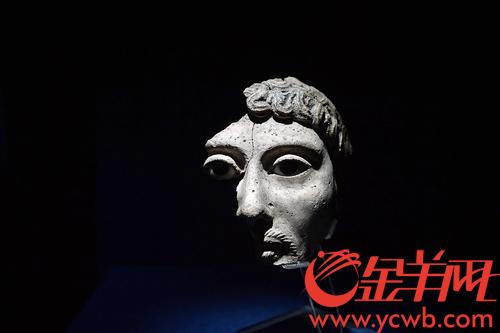 Echoes on the banks of the Nile River——A special exhibition of ancient Egyptian civilizationJinyang.com reporter Deng Bo
Echoes on the banks of the Nile River——A special exhibition of ancient Egyptian civilizationJinyang.com reporter Deng Bo
Book of the Dead
The mysterious “Book of the Dead” in the movie can also be seen. The exhibits exhibits are 3 meters long, restore the content of 30 chapters, and are written in vertical lines in hieroglyphs. The Book of the Dead is a document that appeared in the New Kingdom of Ancient Egypt to provide guidance for the rituals of tombs, written with various songs of the gods, mantras for demons and prayers to help the deceased overcome all obstacles in the underworld.
This book of the dead is from right to left: in the testimony of God Osiris, the next dead person is guided by God Anubis; a deceased expresses respect to the gods in the “field of reeds”; Osiris determines the fate of each deceased in the Court of Justice.
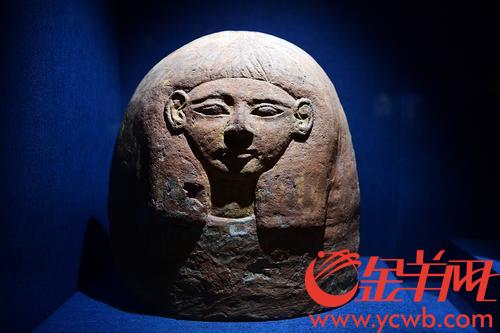 Echoes on the banks of the Nile River—Special Exhibition of Ancient Egyptian Civilizations Golden Sheep Network Reporter Deng Bo
Echoes on the banks of the Nile River—Special Exhibition of Ancient Egyptian Civilizations Golden Sheep Network Reporter Deng Bo
Kongsu Pyramid
Stones in the shape of pyramids, usually appear on the spire of the pyramid or obelisk, are tooBabaylan<a The symbol of sunshine, the carved pattern of the tower body expresses the worship and awe of the ancient Egyptians for the sun.
This small golden letter CinemaThe east side of the tower carves the image of a scarab, symbolizing the rise of the sun. The west side of the small pyramid carved the eagle-headed god Ra Halati, which is the union of the sun god and the “Horus of the horizon”, as a symbol of the horizon; the other sides carved the image of the master of the tomb and his relatives kneeling to worship the sun god. On one side, there is the image of Atum, the sun god who is sailing in the sky on a boat.
The owner of this small pyramid is Kong Su, a craftsman from Delmay Village. The people living in this village were mainly craftsmen who built tombs for the Valley of Kings and Queens.There are many such small pyramids in the cemetery of the village.
Cinema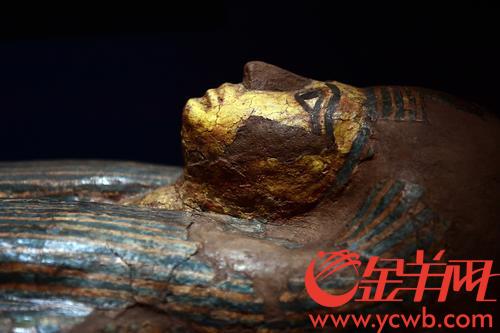 Echoes on the banks of the Nile – Special Exhibition of Ancient Egyptian Civilizations Golden Sheep Net Reporter Deng Bo
Echoes on the banks of the Nile – Special Exhibition of Ancient Egyptian Civilizations Golden Sheep Net Reporter Deng Bo
Pardi Amonimop Mummy and Human-shaped Coffin
The whole body of the mummy is wrapped with bandages and covered with a layer of mesh cover, in order to protect the deceased from being violated by devils or evil spirits. The mesh cover is decorated with four sons of scarab and Horus, which can further enhance the protection energy. If the mummy is still damaged under these protective measures, the deceased’s body can still be replaced by a human-shaped wooden coffin. The coffin is made of painted wood, and is in the shape of the Babaylan, which matches the corpse, and has intricate painted decorations inside.
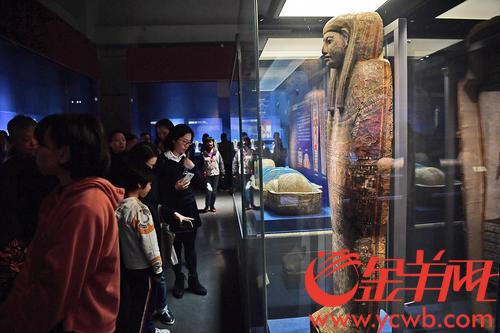 Echoes on the banks of the Nile – Special Exhibition of Ancient Egyptian Civilization Jinyang.com reporter Deng Bo
Echoes on the banks of the Nile – Special Exhibition of Ancient Egyptian Civilization Jinyang.com reporter Deng Bo
Sandals
The ancient Egyptian sandals are very “beautiful”, and they can lead the fashion today – the fish bone-style soles are bent at the toes and connected to the straps that fix the ankles. In fact, the ancient Egyptians were barefoot, and only royal nobles and clergy were qualified to wear shoes, and they were only worn during rituals.
What’s special about the shoe is that its upper is very low and extends from the front of the foot along both sides of the foot to the heels. The shoe has lace decoration at the edges, the insoles are thoughtful and the fishbone-like insoles are bent at the toe and connected to the straps that hold the ankle. These sandalsBabaylan‘s workmanship is usually very exquisite.
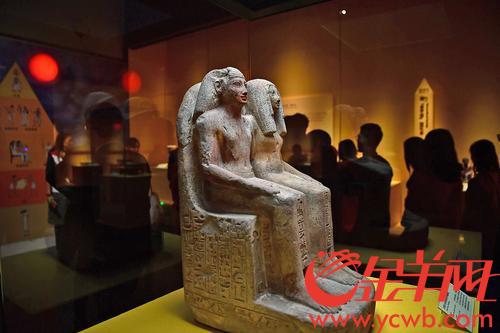 Echoes on the banks of the Nile – Special Exhibition of Ancient Egyptian Civilization Jinyang.com reporter Deng Bo
Echoes on the banks of the Nile – Special Exhibition of Ancient Egyptian Civilization Jinyang.com reporter Deng Bo
Animal-shaped makeup spoon
The eye makeup of the ancient Egyptians affected many women in later generations. Makeup spoons were one of the necessary items for the ancient Egyptians to make up. Among the exhibits is an animal-shaped makeup spoon, with antelope shape and a sunken spoon to hold makeupBabaylan product, with the side carefully depicting the head features and can be used for handheld. The four hooves are tied together, showing that it is a sacrifice.
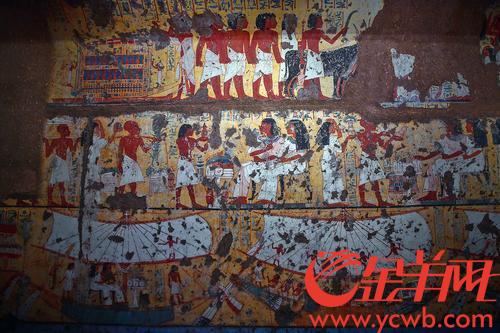 Echoes on the banks of the Nile – Special Exhibition of Ancient Egyptian Civilizations Jinyang.com Reporter Deng Bo
Echoes on the banks of the Nile – Special Exhibition of Ancient Egyptian Civilizations Jinyang.com Reporter Deng Bo
Academic Lecture on Egypt Exhibition
1. Ancient Egyptian Code: Start with the Abu Cao Stone Stele
Speaker: Professor Li Xiaodong
Time: December 20 (Thursday) at 14:30 pm
Spot: Academic Lecture Hall
2. View Religious Beliefs from Egyptian Art
Speaker: Professor Pu Muzhou
Time: January 12 (Saturday) at 14:30 pm
Spot: Academic Lecture Hall
3. How ancient Egyptians “art” their lives
Speaker: Professor Huang Zixuan
Time: January 26 (Saturday) at 10:00 AM
Spot: Academic Lecture Hall
4. “The Book of the Dead” and the Faith of the Ancient Egyptians
Speaker: Professor Yan Haiying
Time: March 2 (Saturday) at 14:30 pm
Spot: Academic Lecture Hall